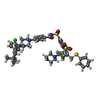+ Open data
Open data
- Basic information
Basic information
| Entry | Database: PDB / ID: 6qgh | ||||||
|---|---|---|---|---|---|---|---|
| Title | Structure of human Bcl-2 in complex with ABT-263 | ||||||
 Components Components | Apoptosis regulator Bcl-2,Bcl-2-like protein 1,Apoptosis regulator Bcl-2,Bcl-2-like protein 1 | ||||||
 Keywords Keywords | APOPTOSIS / BCL2 / ABT-263 / drug design | ||||||
| Function / homology |  Function and homology information Function and homology informationnegative regulation of cellular pH reduction / negative regulation of retinal cell programmed cell death / pigment granule organization / CD8-positive, alpha-beta T cell lineage commitment / BAD-BCL-2 complex / positive regulation of skeletal muscle fiber development / regulation of glycoprotein biosynthetic process / positive regulation of melanocyte differentiation / channel inhibitor activity / melanin metabolic process ...negative regulation of cellular pH reduction / negative regulation of retinal cell programmed cell death / pigment granule organization / CD8-positive, alpha-beta T cell lineage commitment / BAD-BCL-2 complex / positive regulation of skeletal muscle fiber development / regulation of glycoprotein biosynthetic process / positive regulation of melanocyte differentiation / channel inhibitor activity / melanin metabolic process / positive regulation of neuron maturation / myeloid cell apoptotic process / cochlear nucleus development / osteoblast proliferation / mesenchymal cell development / retinal cell programmed cell death / negative regulation of osteoblast proliferation / stem cell development / gland morphogenesis / apoptotic process in bone marrow cell / renal system process / regulation of cell-matrix adhesion / The NLRP1 inflammasome / dendritic cell apoptotic process / ear development / dendritic cell proliferation / positive regulation of mononuclear cell proliferation / SARS-CoV-1-mediated effects on programmed cell death / negative regulation of calcium ion transport into cytosol / lymphoid progenitor cell differentiation / melanocyte differentiation / T cell apoptotic process / negative regulation of myeloid cell apoptotic process / negative regulation of epithelial cell apoptotic process / BH3-only proteins associate with and inactivate anti-apoptotic BCL-2 members / regulation of nitrogen utilization / glomerulus development / negative regulation of dendritic cell apoptotic process / focal adhesion assembly / regulation of transmembrane transporter activity / negative regulation of T cell apoptotic process / negative regulation of intrinsic apoptotic signaling pathway in response to DNA damage / oocyte development / B cell apoptotic process / metanephros development / neuron maturation / negative regulation of motor neuron apoptotic process / Regulation of MITF-M-dependent genes involved in apoptosis / positive regulation of multicellular organism growth / regulation of viral genome replication / negative regulation of mitochondrial outer membrane permeabilization involved in apoptotic signaling pathway / endoplasmic reticulum calcium ion homeostasis / negative regulation of execution phase of apoptosis / regulation of mitochondrial membrane permeability / fertilization / regulation of growth / calcium ion transport into cytosol / negative regulation of ossification / response to UV-B / response to iron ion / negative regulation of mitochondrial depolarization / epithelial cell apoptotic process / Bcl-2 family protein complex / axon regeneration / motor neuron apoptotic process / positive regulation of smooth muscle cell migration / smooth muscle cell migration / NFE2L2 regulating tumorigenic genes / intrinsic apoptotic signaling pathway in response to oxidative stress / negative regulation of B cell apoptotic process / organ growth / hair follicle morphogenesis / branching involved in ureteric bud morphogenesis / response to cycloheximide / STAT5 activation downstream of FLT3 ITD mutants / negative regulation of intrinsic apoptotic signaling pathway in response to DNA damage by p53 class mediator / B cell lineage commitment / hepatocyte apoptotic process / digestive tract morphogenesis / negative regulation of G1/S transition of mitotic cell cycle / negative regulation of release of cytochrome c from mitochondria / pore complex / cellular response to alkaloid / negative regulation of intrinsic apoptotic signaling pathway / apoptotic mitochondrial changes / germ cell development / negative regulation of reproductive process / negative regulation of developmental process / T cell homeostasis / B cell homeostasis / BH3 domain binding / regulation of calcium ion transport / B cell proliferation / humoral immune response / negative regulation of anoikis / negative regulation of apoptotic signaling pathway / intrinsic apoptotic signaling pathway in response to endoplasmic reticulum stress / extrinsic apoptotic signaling pathway via death domain receptors / Estrogen-dependent nuclear events downstream of ESR-membrane signaling / Activation of BAD and translocation to mitochondria Similarity search - Function | ||||||
| Biological species |  Homo sapiens (human) Homo sapiens (human) | ||||||
| Method |  X-RAY DIFFRACTION / X-RAY DIFFRACTION /  MOLECULAR REPLACEMENT / Resolution: 2 Å MOLECULAR REPLACEMENT / Resolution: 2 Å | ||||||
 Authors Authors | Dokurno, P. / Murray, J. / Davidson, J. / Chen, I. / Davis, B. / Graham, C.J. / Harris, R. / Jordan, A.M. / Matassova, N. / Pedder, C. ...Dokurno, P. / Murray, J. / Davidson, J. / Chen, I. / Davis, B. / Graham, C.J. / Harris, R. / Jordan, A.M. / Matassova, N. / Pedder, C. / Ray, S. / Roughley, S. / Smith, J. / Walmsley, C. / Wang, Y. / Whitehead, N. / Williamson, D.S. / Casara, P. / Le Diguarher, T. / Hickman, J. / Stark, J. / Kotschy, A. / Geneste, O. / Hubbard, R.E. | ||||||
 Citation Citation |  Journal: Acs Omega / Year: 2019 Journal: Acs Omega / Year: 2019Title: Establishing Drug Discovery and Identification of Hit Series for the Anti-apoptotic Proteins, Bcl-2 and Mcl-1. Authors: Murray, J.B. / Davidson, J. / Chen, I. / Davis, B. / Dokurno, P. / Graham, C.J. / Harris, R. / Jordan, A. / Matassova, N. / Pedder, C. / Ray, S. / Roughley, S.D. / Smith, J. / Walmsley, C. / ...Authors: Murray, J.B. / Davidson, J. / Chen, I. / Davis, B. / Dokurno, P. / Graham, C.J. / Harris, R. / Jordan, A. / Matassova, N. / Pedder, C. / Ray, S. / Roughley, S.D. / Smith, J. / Walmsley, C. / Wang, Y. / Whitehead, N. / Williamson, D.S. / Casara, P. / Le Diguarher, T. / Hickman, J. / Stark, J. / Kotschy, A. / Geneste, O. / Hubbard, R.E. | ||||||
| History |
|
- Structure visualization
Structure visualization
| Structure viewer | Molecule:  Molmil Molmil Jmol/JSmol Jmol/JSmol |
|---|
- Downloads & links
Downloads & links
- Download
Download
| PDBx/mmCIF format |  6qgh.cif.gz 6qgh.cif.gz | 52.7 KB | Display |  PDBx/mmCIF format PDBx/mmCIF format |
|---|---|---|---|---|
| PDB format |  pdb6qgh.ent.gz pdb6qgh.ent.gz | 35.4 KB | Display |  PDB format PDB format |
| PDBx/mmJSON format |  6qgh.json.gz 6qgh.json.gz | Tree view |  PDBx/mmJSON format PDBx/mmJSON format | |
| Others |  Other downloads Other downloads |
-Validation report
| Summary document |  6qgh_validation.pdf.gz 6qgh_validation.pdf.gz | 728.1 KB | Display |  wwPDB validaton report wwPDB validaton report |
|---|---|---|---|---|
| Full document |  6qgh_full_validation.pdf.gz 6qgh_full_validation.pdf.gz | 729.9 KB | Display | |
| Data in XML |  6qgh_validation.xml.gz 6qgh_validation.xml.gz | 9.8 KB | Display | |
| Data in CIF |  6qgh_validation.cif.gz 6qgh_validation.cif.gz | 13.3 KB | Display | |
| Arichive directory |  https://data.pdbj.org/pub/pdb/validation_reports/qg/6qgh https://data.pdbj.org/pub/pdb/validation_reports/qg/6qgh ftp://data.pdbj.org/pub/pdb/validation_reports/qg/6qgh ftp://data.pdbj.org/pub/pdb/validation_reports/qg/6qgh | HTTPS FTP |
-Related structure data
| Related structure data |  6qfiC  6qfmC 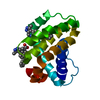 6qfqC  6qg8C 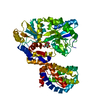 6qgdC  6qggSC  6qgjC  6qgkC C: citing same article ( S: Starting model for refinement |
|---|---|
| Similar structure data |
- Links
Links
- Assembly
Assembly
| Deposited unit | 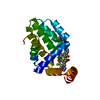
| ||||||||
|---|---|---|---|---|---|---|---|---|---|
| 1 |
| ||||||||
| Unit cell |
|
- Components
Components
| #1: Protein | Mass: 20442.461 Da / Num. of mol.: 1 Mutation: H20S, L95Q, R106L, F124G, R127Y, G128A, R129S, P168V, L175A, T178A, E179T, R183D Source method: isolated from a genetically manipulated source Source: (gene. exp.)  Homo sapiens (human) / Gene: BCL2, BCL2L1, BCL2L, BCLX / Production host: Homo sapiens (human) / Gene: BCL2, BCL2L1, BCL2L, BCLX / Production host:  |
|---|---|
| #2: Chemical | ChemComp-1XJ / |
| #3: Water | ChemComp-HOH / |
-Experimental details
-Experiment
| Experiment | Method:  X-RAY DIFFRACTION / Number of used crystals: 1 X-RAY DIFFRACTION / Number of used crystals: 1 |
|---|
- Sample preparation
Sample preparation
| Crystal | Density Matthews: 1.94 Å3/Da / Density % sol: 36.49 % |
|---|---|
| Crystal grow | Temperature: 284 K / Method: vapor diffusion, sitting drop / pH: 5.5 Details: 0.2 M NaCl, 25% PEG3350 and 0.1 M Bis-Tris buffer pH 5.5 |
-Data collection
| Diffraction | Mean temperature: 100 K / Serial crystal experiment: N | |||||||||||||||||||||||||||||||||||||||||||||||||||||||||||||||||||||||||||||
|---|---|---|---|---|---|---|---|---|---|---|---|---|---|---|---|---|---|---|---|---|---|---|---|---|---|---|---|---|---|---|---|---|---|---|---|---|---|---|---|---|---|---|---|---|---|---|---|---|---|---|---|---|---|---|---|---|---|---|---|---|---|---|---|---|---|---|---|---|---|---|---|---|---|---|---|---|---|---|
| Diffraction source | Source:  ROTATING ANODE / Type: RIGAKU RUH3R / Wavelength: 1.5418 Å ROTATING ANODE / Type: RIGAKU RUH3R / Wavelength: 1.5418 Å | |||||||||||||||||||||||||||||||||||||||||||||||||||||||||||||||||||||||||||||
| Detector | Type: RIGAKU RAXIS IV++ / Detector: IMAGE PLATE / Date: Aug 29, 2008 | |||||||||||||||||||||||||||||||||||||||||||||||||||||||||||||||||||||||||||||
| Radiation | Protocol: SINGLE WAVELENGTH / Monochromatic (M) / Laue (L): M / Scattering type: x-ray | |||||||||||||||||||||||||||||||||||||||||||||||||||||||||||||||||||||||||||||
| Radiation wavelength | Wavelength: 1.5418 Å / Relative weight: 1 | |||||||||||||||||||||||||||||||||||||||||||||||||||||||||||||||||||||||||||||
| Reflection | Resolution: 1.9→27.9 Å / Num. obs: 12847 / % possible obs: 98 % / Redundancy: 4.62 % / Rmerge(I) obs: 0.103 / Rrim(I) all: 0.103 / Χ2: 0.96 / Net I/σ(I): 8.1 / Num. measured all: 59783 / Scaling rejects: 450 | |||||||||||||||||||||||||||||||||||||||||||||||||||||||||||||||||||||||||||||
| Reflection shell | Diffraction-ID: 1
|
- Processing
Processing
| Software |
| ||||||||||||||||||||||||||||||||||||||||||||||||||||||||||||
|---|---|---|---|---|---|---|---|---|---|---|---|---|---|---|---|---|---|---|---|---|---|---|---|---|---|---|---|---|---|---|---|---|---|---|---|---|---|---|---|---|---|---|---|---|---|---|---|---|---|---|---|---|---|---|---|---|---|---|---|---|---|
| Refinement | Method to determine structure:  MOLECULAR REPLACEMENT MOLECULAR REPLACEMENTStarting model: 6qgg Resolution: 2→20 Å / Cor.coef. Fo:Fc: 0.959 / Cor.coef. Fo:Fc free: 0.947 / SU B: 4.562 / SU ML: 0.121 / SU R Cruickshank DPI: 0.1951 / Cross valid method: THROUGHOUT / σ(F): 0 / ESU R: 0.195 / ESU R Free: 0.154 Details: HYDROGENS HAVE BEEN ADDED IN THE RIDING POSITIONS U VALUES : REFINED INDIVIDUALLY
| ||||||||||||||||||||||||||||||||||||||||||||||||||||||||||||
| Solvent computation | Ion probe radii: 0.8 Å / Shrinkage radii: 0.8 Å / VDW probe radii: 1.2 Å | ||||||||||||||||||||||||||||||||||||||||||||||||||||||||||||
| Displacement parameters | Biso max: 77.75 Å2 / Biso mean: 29.571 Å2 / Biso min: 15.55 Å2
| ||||||||||||||||||||||||||||||||||||||||||||||||||||||||||||
| Refinement step | Cycle: final / Resolution: 2→20 Å
| ||||||||||||||||||||||||||||||||||||||||||||||||||||||||||||
| Refine LS restraints |
| ||||||||||||||||||||||||||||||||||||||||||||||||||||||||||||
| LS refinement shell | Resolution: 2→2.107 Å / Rfactor Rfree error: 0 / Total num. of bins used: 10
|
 Movie
Movie Controller
Controller





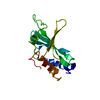
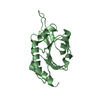

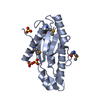
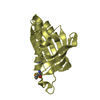

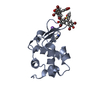
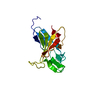
 PDBj
PDBj




